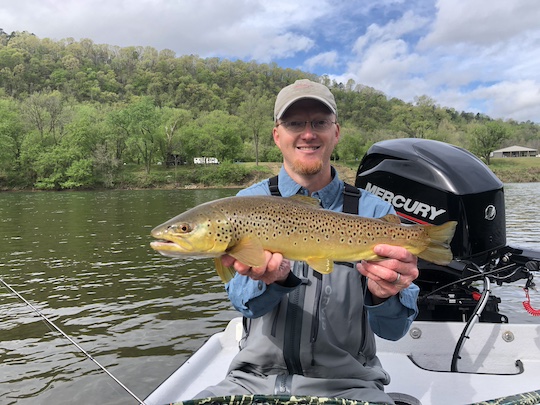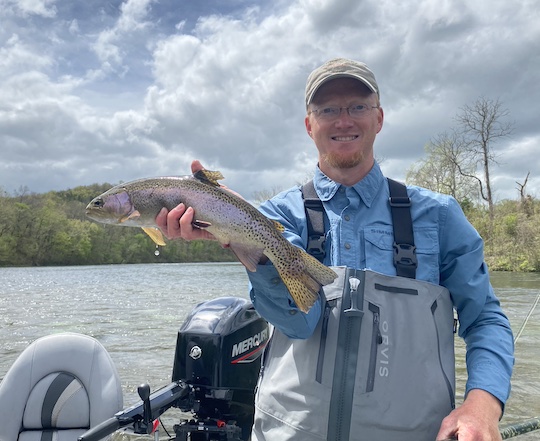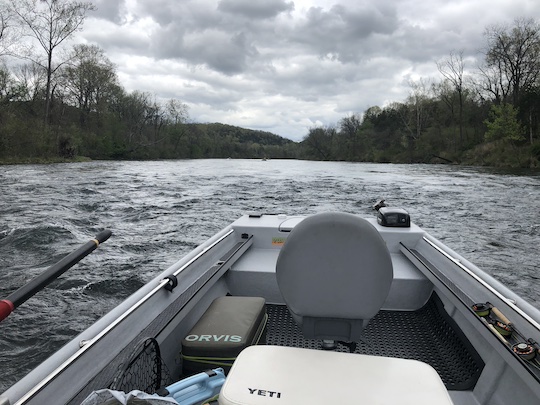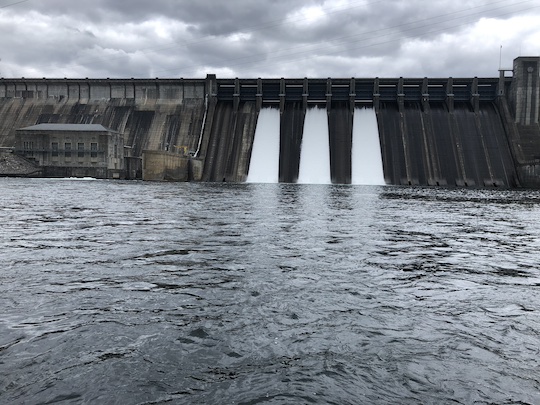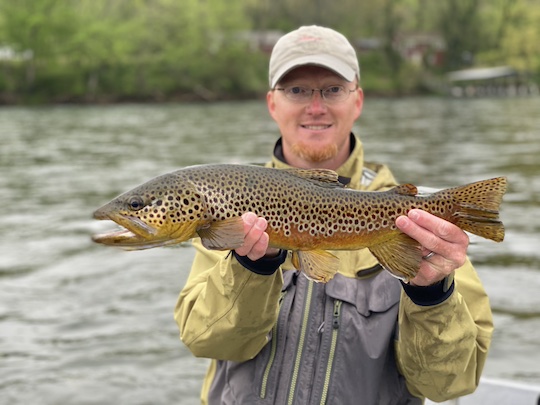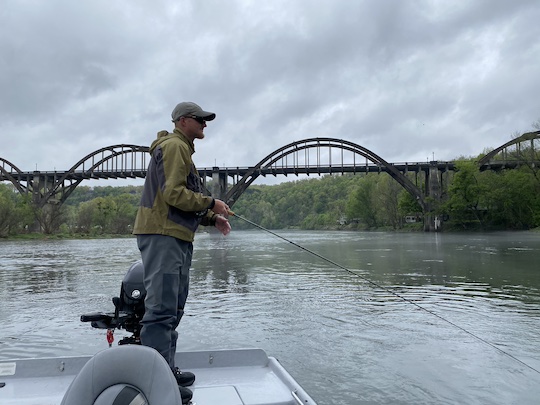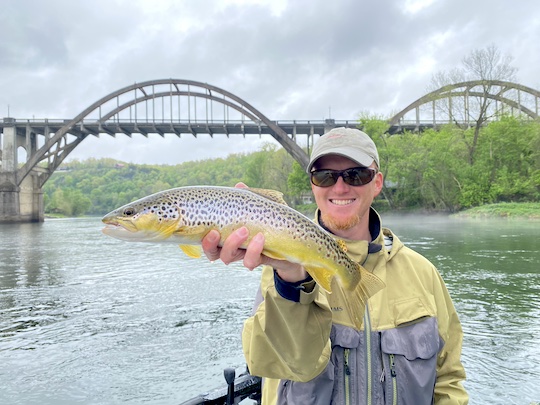Every year, I try to make it over to the Great Smoky Mountains National Park outside of work for a fun trip. As a Great Smoky Mountains fly fishing guide, I need these occasional retreats to stay excited about my home waters. That usually means camping for 2-3 nights and fishing hard for a couple of days. This year, I planned the usual trip, but as the day of the trip drew closer, the weather was looking iffy. After deciding to NOT chicken out, I made the drive over to Smokemont Campground midday on Sunday, and got my tent set up before the rain set in too much. It was sprinkling while I put it up, but thankfully never got serious.
After the tent went up, I was ready to hit the water for a couple of hours before getting a good night's rest. I put together my current all-round favorite rod, a 10' 3 weight Orvis Recon. That rod is literally a do it all workhorse for me. I cast heavy nymph rigs, dry flies, and jig streamers with that rod. Being a little stiffer than most "nymphing" rods, it isn't the best for beginners looking to dry fly fish because you don't feel the rod load like you might with a softer rod, but it can handle anything you throw at it with a little practice.
First Day Streamer Fishing for Quality Brown Trout
With the clouds and rain lingering, I decided to fish for pre-spawn brown trout with streamers. This time of year, brown trout are getting ready for the fall dance, and while I don't advocate for or recommend fishing to spawning fish, both pre- and post-spawn fish are hungry and looking for a meal. Streamers are a good way to pick up some of these aggressive fish.
I decided to stay close to camp and headed down to some favorite pools nearby. After working through the first run and missing a couple of small fish, I started to hope that the good weather conditions were going to offset the very low water from our ongoing drought conditions. Sure enough, the second pool I jumped into worked out in a big way.
A long flat with a fast run at the head attracted my attention. I've often seen some big fish spawn in the back of that flat, and while I wasn't interested in looking for spawning fish, I was interested in fish that had either already spawned or were preparing to spawn but still looking for that last meal. The fast run at the head of the flat provided a perfect ambush spot. A large boulder on the far bank caused the current to sweep back towards meal while simultaneously providing a perfect spot for a brown trout to hide and wait for a hapless baitfish to swim by.
My first cast was almost too far and fell on top of a submerged boulder just below the primary boulder. I raised my rod to jig the streamer and it got whacked as soon as it fell off the boulder into deeper water. The fish gave several solid runs and head shakes, so I knew it was the typically "average" Smokies fish. Sure enough, moments later I slid a solid 15" pre-spawn female into my big Brodin net. I carefully cradled her in the water while getting a closeup or two. She was not too far off from hopefully producing the next generation, so I was careful to not squeeze under her belly. It isn't too hard to accidentally strip eggs or milt from these fish this time of year, so always play it safe and keep them in the water.
 |
| "First fish of the trip." ©2024 David Knapp Photography |
After soaking in the moment and being thankful for my ability to spend time in such a special place, I worked up to the next pool. Here, I found several large brown trout glued to the bottom. Knowing that a switch to a nymph setup would probably yield a fish or two, I instead decided to work the streamer with an all or nothing mindset. Sure enough, in the swift water at the head of the pool, a big dark shadow chased my streamer and did everything but eat. Several more fruitless casts convinced me that the fish had indeed spooked. Oh well, on to the next spot.
I was feeling lazy at this point with one nice fish already landed, so I walked well upstream to some more easy to access pools. In one of my favorites, another high point of this trip would occur.
I had already missed a fish or two in a couple of small pockets on the walk up. The main pool I was working towards ended up being perfect, however. I started in the back, carefully working every bit of real estate with my jig streamer. Just as I was about to give up, I figured, "One more shot in the very head." Sure enough, the pattern was starting to crystallize. My streamer jigged once and then got slammed. This was obviously a larger fish than my first nice brown. I was hoping to maybe break 20" or better, but it wasn't quite meant to be. Still, a solid 17" brown trout in the Smokies is a fine fish any day. I got a picture or two, then continued up to look at a couple last pools before heading to camp to fix supper.
 |
| "Evening streamer eater." ©2024 David Knapp Photography |
Day One Evening In Camp
Nothing particularly interesting happened in the last two holes but I did miss another fish. There is no telling how big (or not) it was. Back in camp, I put together some chili, chips, cheese, and sour cream for a nice hot meal. The rain was still holding off when my buddy and fellow fly fishing guide Pat Tully showed up. He was going to camp for one night, fish the next day, then needed to be back home.
We chatted for a while before crawling into our sleeping bags for the night. I was tired from working many long days, and fell asleep quickly. Morning came sooner than expected, but I felt rested after a night in the fresh air. After a quick breakfast, we decided to fish nearby for the day on the Oconaluftee. This proved to be a nice relaxing choice.
Day Two Fly Fishing the Oconaluftee River
Regardless of whether I am fishing for myself or guiding, spending time on the "Luftee is always a treat. The river has a nice mix of water types and sizes. We started down low looking for larger brown trout. The best we could find was in that 12-13" range and while beautiful, definitely wasn't what we had come looking for. A few other trout including some nicer stocker rainbows kept us entertained, but we wanted something more or different. Before totally giving up, we decided to just "fish through" a section of water, and a fairly length one at that.
I sometimes joke about how lazy I've become as an angler. This is probably a by-product of being on the water every day, but when I'm fishing for myself, I just don't put as much effort as I used to. Note that this does not extend to my "work" fishing. I still try as hard as ever to put people on fish, but I think part of it for me is just the joy of being out there, and catching fish has truly become secondary to the overall experience for me personally. Some of it may just be the residual exhaustion of having little ones at home. Either way, this was all best illustrated during this fishing session.
Pat and I were working up that section of water and decided to skip a section with the goal of getting even higher up the stream. In the process of walking up, we ended up on a high bank looking down in a great run that always looks super fishy. Sure enough, I quickly spotted a big fish. Maybe not a true monster, but no one in their right mind would scoff at a two foot long or better brown trout. This fish was laying deep in back of the run, probably at least 4 feet deep. Two or three other fish that were very nice in their own right sat just below. Fish were clearly staging for the upcoming spawn, and these fish were waiting for better water or weather conditions to move up and do their thing.
The funny thing about the lazy part (which you might have guessed was coming) is that when I told Pat he was welcome to fish for those fish, he declined and we both decided to walk away from close to a sure thing. I can't say for certain that we would have caught those fish, but they were exactly the kind of fish that we can usually get to eat something. Since I had spotted them first, they were technically "my fish." When I offered them to Pat, I was kind of hoping he would slide down that steep bank and catch them. Once he declined, it quickly became obvious that we were out for something more than a 24" brown.
Moments like that leave me wondering just how big a fish needs to be for me to really go out of my way these days. Hopefully I'll have a reason to find out sometime soon, but it wasn't meant to be on this particular trip. In hindsight, I probably should have fished for those fish, but I was more interested in seeing what else might be happening. So, in the end, I'm left realizing that while I don't fish as hard as I used to, it is also the curiosity that keeps driving me on. I'm often willing to walk away from the known quantity in fishing to see what else might be.
When we got to the end of that section without finding anymore monsters, it motivated us to try something a little different which proved to be just the right call.
Tenkara Fishing in the Great Smoky Mountains
For the last several months at least and maybe longer, Pat and I have been talking about doing some Tenkara fishing. While it is something that I do both for personal fishing and guiding/work fishing, it was new for him. When we got back to our vehicles and I mentioned that I had a couple Tenkara rods with me, Pat was all for it. Something new and at the same time something instructional was a good idea. As guides, we are always trying to add to our repertoire of offerings, and I've been telling Pat for a while that he should work on being able to guide Tenkara anglers. While I don't run a ton of Tenkara only trips, it happens often enough that we could use at least one more guide who can offer Tenkara trips also.
 |
| "David Knapp fishing Tenkara in the Great Smoky Mountains." Photo courtesy of Pat Tully ©2024 |
We headed upstream to where the river gets smaller, fitting in perfectly with my philosophy on the best application for this method. One section of pocket water in particular just happened to be a favorite of both of ours. I pulled out rods and showed Pat how to rig up. Once we got it all together, I showed him the nuances of casting a Tenkara rod compared to a "regular" fly rod. In the process, I found our first Tenkara fish of the day. This fish was my favorite of the day, because it came on the Tenkara rod instead of my usual fly rod.
 |
| "First Tenkara fish of the day." Photo courtesy of Pat Tully ©2024 |
Pat took over from there and soon we were taking turns every other fish. One of the best moments came a short distance upstream when Pat found a gorgeous brown trout of his own. This fish fought like a tiger on the light Tenkara rod and Pat was left grinning with a new found appreciation for the "glorified cane pole fishing" methods we were using.
 |
| "Pat's first Tenkara brown trout." ©2024 David Knapp Photography |
 |
| "Close-up of Pat's pretty brown trout." ©2024 David Knapp Photography |
Shortly after that nice brown, we finished up our day. I wanted to kick around closer to camp a little and Pat was heading back home that evening. So, we went our separate ways.
Day Two Evening In Camp
After Pat left, I went down to check on another favorite section of water close to camp. I ended up calling it quits with some daylight still left. I had covered a lot of water that day and my legs were getting tired. I've finally learned that bad things like falls usually happen when I'm getting tired, and I'm no longer too proud to call it a day.
Back in camp, I was glad that I had called it. The evening was cooling down rapidly, and I wanted to get my supper and evening chores done before it got too cold. My warm sleeping bag was already calling to me. After a warm supper and a little time to relax in camp, I crawled into my sleeping bag and was soon asleep. Having little ones at home means that I have to take advantage of the opportunity to get extra sleep when it comes around. I took full advantage that night, going to bed shortly after dark and sleeping soundly until day break.
Day Three Fly Fishing Noland Creek
I didn't know it that morning, but this would be my last day of fishing on this trip. The plan that day was for one of my other guides, Chris Bean, to join me to explore up Noland Creek. I've been slowly working my way up that stream and was ready to fish a "new" to me section. Chris hadn't done much there, so he was ready to explore as well.
He got there in a timely manner, and I was still eating my granola, yogurt, pecans, and banana breakfast. It wasn't long before I was ready, however, and we headed out of the campground and west towards Bryson City. One of my favorite little mountain towns, I didn't spend much time there on this trip, but it is always a good time driving through on my way to one of the local trout streams.
For this trip, it was hard to pass the turn to Deep Creek, but we made ourselves stick to the plan and continued on down the Road To Nowhere (AKA Lakeshore Drive). There were already a couple of vehicles at the Noland Creek trailhead, but there was no sign of them anywhere as we geared up and hiked in. By the time we got to a good starting point, the sun was starting to work down in to the stream bottom and warm things up.
 |
| "Noland Creek is beautiful." ©2024 David Knapp Photography |
It didn't take long to start finding fish. I didn't know if the cool night was going to be a problem, but it turned out that fish were active more or less from the get go that morning. That said, there was a noticeable surge in activity during the warmest part of the afternoon before it abruptly started shutting down as the shadows lengthened towards the end of the day. This time of year, with the low sun angle, that starts much earlier than people think.
 |
| "Chris high sticking on Noland Creek." ©2024 David Knapp Photography |
In between that first fish and moment activity started slowing down, we found a respectable number of fish without really catching enough to get bored with it. We had to work just hard enough to keep things enjoyable and even caught a few on dry flies. In between, we had lots of good conversation while leap frogging our way upstream. Often, we would each take one side of the stream and take turns fishing depending on which side had the best angle on any given spot.
While we didn't find anything particularly noteworthy from a fishing standpoint beyond the standard Smoky Mountain rainbows, I did find some extensive hog sign. One area looked like it had been rototilled while another couple of spots had very obvious and recently utilized wallows. I always hate to see the widespread damage caused by these invasive pests.
 |
| "Extensive rooting from wild hogs on Noland Creek." ©2024 David Knapp Photography |
 |
| "Hog Wallow on Noland Creek." ©2024 David Knapp Photography |
We were having a great time fishing, but as the sun dropped and the bite abruptly started to shut down, we both agreed that getting out at a reasonable time was best. Making good time on the way out, I started to contemplate my own warm house and soft bed. Moreover, I was missing the family back home. When we got back to camp, I made up my mind to tear down camp as fast as I could and head home.
 |
| "Another glimpse of Noland Creek." ©2024 David Knapp Photography |
Originally, I was supposed to stay another night and fish a little more the next day before heading home. However, priorities have a way of shifting in life. I was more than satisfied with the wonderful getaway and fishing but was raring to get back home. And just like that, yet another fishing trip drew to a close. Chris and I caravanned over the hill back to the TN side in the waning light of a November evening. Shortly after exiting the Park with it getting dark, I called to surprise my family with news of my early return. Thankfully they were glad to get me back.
Trip Wrap Up
It had been another successful trip. While my measure of success has shifted a TON over the years, I had seen some new water (super high on the list of things that I consider making a trip successful), caught fish, spent time with friends, and even made a new fishing friend back in camp. It had been an excellent trip, and I'll look forward to doing it again next year.





























